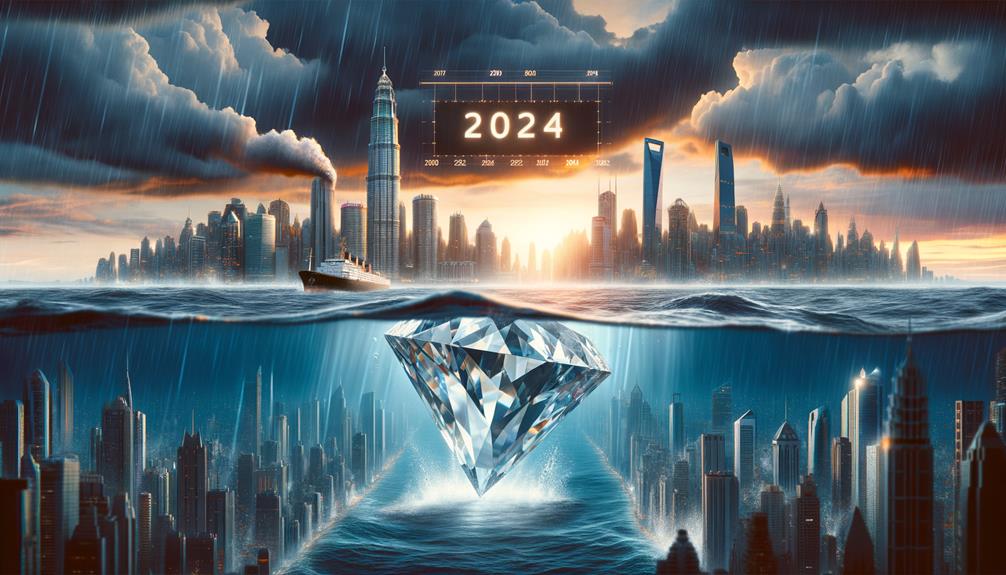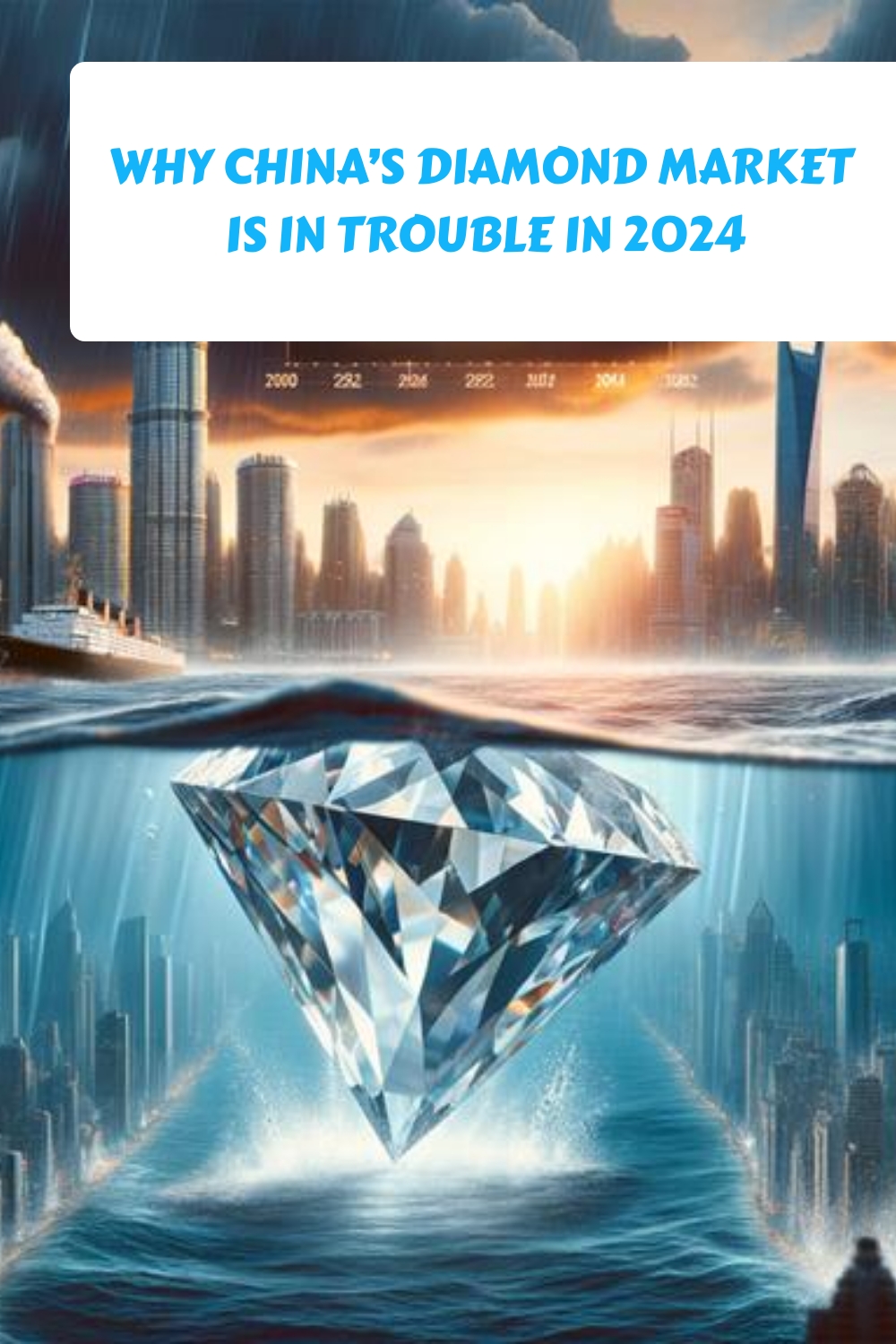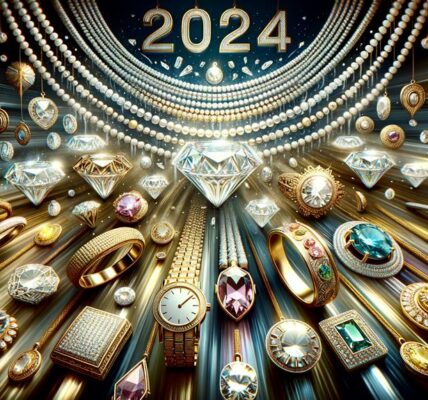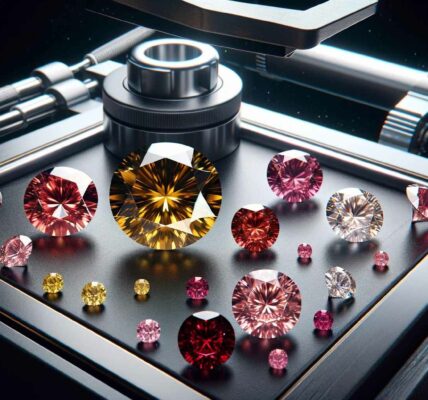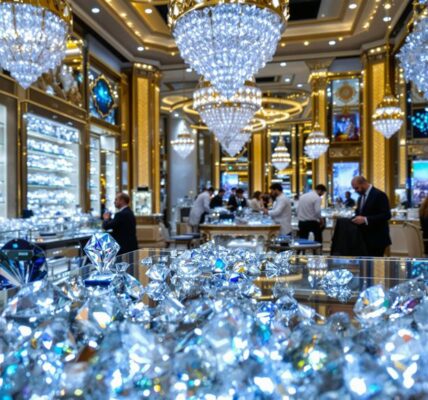What if I told you that China’s diamond market, once a dazzling beacon of wealth and prosperity, is now teetering on the edge of a crisis?
A precipitous drop in diamond prices, a sudden slowdown in consumer demand, and an unexpected shift towards lab-grown diamonds are painting a grim picture for the Chinese diamond market in 2024.
The ripples of a troubled Chinese real estate sector are unsettling consumer confidence, adding another layer of instability.
While there are industry attempts to steady the ship, the future remains shrouded in uncertainty.
As you peel back the layers of this complex issue, you’ll find a potent mix of macroeconomic vulnerabilities and changing consumer behaviours sculpting the diamond landscape in unforeseen ways.
So, what’s casting these ominous shadows over China’s diamond market? Let’s take a closer look.
Article Contents
- 1 Key Takeaways About Why China’s Diamond Market is Facing Problems
- 2 Understanding the Diamond Price Drop
- 3 Impact of the Pandemic on Diamond Demand
- 4 Effects of China’s Real Estate Crisis
- 5 Rise of Lab-Grown Diamonds in China
- 6 Efforts to Stabilize Diamond Prices
- 7 Macro-Economic Weakness and the Diamond Trade
- 8 Changing Consumer Choices in China’s Diamond Market
- 9 Frequently Asked Questions
- 10 Conclusion
- 11 Further Reading About China’s Diamond Market Challenges
Key Takeaways About Why China’s Diamond Market is Facing Problems
- Diamond prices in China have dropped significantly due to factors such as the negotiation of rates by Indian exporters, the impact of lab-grown diamonds and slow consumer demand, and the Chinese real estate crisis affecting consumer confidence.
- The pandemic has further worsened the situation, with a decline in consumer confidence leading to a decrease in luxury purchases, including diamonds. This has resulted in a surplus of diamonds and the threat of job losses in the diamond industry.
- The rise of lab-grown diamonds in China is a significant factor in the troubled diamond market. Chinese consumers prefer ethical lab-grown diamonds, which are generally less expensive than mined diamonds and align with shifting consumer preferences towards sustainability and affordability.
- The real estate crisis in China has also played a role in the decline of the diamond market, as it has dented consumer confidence and led to a decrease in diamond purchases. This crisis has had a global impact on diamond markets and has prompted the industry to adapt and evolve.
Understanding the Diamond Price Drop
To comprehend the steep decline in diamond prices, it’s crucial to examine the challenges faced by key players like Indian exporters, who are now negotiating rates with Chinese buyers and diversifying their markets to clear inventories. The diamond market has evolved into a difficult battlefield with numerous factors influencing diamond pricing.
For instance, the rise of lab-grown diamonds has inevitably shaken the market. The decline in diamond prices isn’t a sudden phenomenon but a result of slow consumer demand. Additionally, China’s real estate crisis has dented consumer confidence, affecting diamond demand further.
Indian exporters, in an attempt to weather this storm, aren’t only negotiating prices with Chinese buyers but also expanding their reach. They’re searching for new markets in Vietnam, Saudi Arabia, and South America.
However, with rough diamonds that were selling at $2,500 per carat in 2022 now being sold around $1,750, the Indian diamond trade is facing significant problems. The refusal of high-profile luxury jewelry players to buy Russian stones adds another layer of complexity to the issue.
Thus, understanding this price drop is crucial for navigating the changing currents of the diamond industry.
Impact of the Pandemic on Diamond Demand

Amid the COVID-19 pandemic, the diamond industry’s demand took a significant hit, leading to a substantial drop in diamond prices, an unexpected surplus, and a looming threat of job losses.
You might wonder how the pandemic has influenced diamond demand. Here are three key ways:
- Decline in Consumer Confidence: As the pandemic wreaked havoc, the economic turmoil resulted in dwindling Chinese consumer confidence, leading to a decline in luxury purchases, including diamonds.
- Surplus of Diamonds: Lower demand meant an unexpected surplus in the diamond market. With fewer buyers, prices plummeted, creating a ripple effect within the industry.
- Job Losses: With the drop in demand and prices, the industry faced a threat of job losses, adding to the overall economic distress.
It’s clear that the impact of the pandemic on diamond demand has been profound, altering the dynamics of the diamond market significantly.
As we navigate the post-pandemic era, we must stay attuned to these changes, understanding their implications for the future of the industry. Together, we can weather this storm and emerge stronger.
Effects of China’s Real Estate Crisis
While the pandemic’s impact on diamond demand has been significant, it’s crucial to consider another major factor shaking the industry: China’s real estate crisis. This crisis has severely dented consumer confidence, making them wary of investing in luxury items like diamonds.
You see, the diamond markets in China and Hong Kong have traditionally been robust. However, the real estate crisis has created an atmosphere of financial instability, causing consumers to hold back on purchasing diamonds. This has further led to a price drop, adversely affecting the diamond industry.
Rough diamonds that used to sell at $2,500 per carat in 2022 are now going for around $1,750. This price drop has hit diamond manufacturers and exporters hard. The diamond industry is struggling to keep afloat amid these challenges. Diamond traders in India, a major supplier of polished diamonds to China, are feeling the pressure, too.
In short, China’s real estate crisis isn’t just a national issue. It’s impacting global diamond markets, creating a ripple effect that’s causing industry-wide concerns. It’s a wake-up call for the diamond industry to adapt and evolve.
Rise of Lab-Grown Diamonds in China

In the shadow of China’s diamond market challenges, there’s a bright spot – the rise of lab-grown diamonds, driven by a surge in demand for sustainable, ethical alternatives to mined diamonds. You’re seeing a shift in the market, where lab diamonds are no longer the fringe choice but are steadily gaining ground.
- Growing preference: Chinese consumers are becoming more aware of ethical issues surrounding natural diamonds. Lab diamonds present a guilt-free option without compromising on quality.
- Technological advancements: Companies like LVMH Moet Hennessy Louis Vuitton are investing in technology to improve the quality and production of lab diamonds, making them more accessible to the average consumer.
- Affordability: Lab diamonds are generally less expensive than mined diamonds, making them an attractive choice for budget-conscious consumers.
As China’s diamond market grapples with a slowdown, lab diamonds offer a glittering alternative that aligns with shifting consumer preferences towards sustainability and affordability. It’s clear that lab diamonds aren’t just a passing trend but a significant player in the future of China’s diamond industry.
Efforts to Stabilize Diamond Prices
Facing the plummeting diamond prices, the industry’s efforts to stabilize the market are multifaceted, encompassing negotiations with Chinese buyers, expanding sales to new regions, and deliberate supply adjustments.
You, as a keen observer, would know that Indian diamond exporters haven’t been idle. They’re actively negotiating with Chinese buyers to clear inventories, selling rough diamonds that were once priced at $2,500 per carat for around $1,750 now.
Moreover, the Gem & Jewellery Export Promotion Council has taken the reins to increase Indian diamond sales in untapped regions like Vietnam, Saudi Arabia, and South America. This strategy extends your market reach, creating a feeling of global belonging.
But there’s more. Diamond miners have started to control the supply of polished diamonds. Smaller tender sales and auctions are now witnessing price increments, and stone shortages are beginning to emerge. This is an attempt to create a scarcity-driven value—a clever move to stabilize prices.
In short, the diamond industry is doing its best to navigate the rough waters. While uncertainties remain, these collective efforts aim to bring back the sparkle to the diamond market, ensuring you remain part of an enduring tradition.
Macro-Economic Weakness and the Diamond Trade

Navigating the choppy waters of macroeconomic weakness, you’ll find the diamond trade grappling with significant challenges, including falling diamond prices and shifting consumer preferences. China’s diamond market is in trouble in 2024, with a significant drop in prices and a slowdown in consumer demand.
The Indian diamond trade, for instance, is trying to clear inventories by negotiating prices in anticipation of Chinese buyers’ demand. However, international pressures from G7 countries regarding the origin of rough diamonds are creating additional hurdles.
The US market is posing significant challenges. High-profile luxury jewelry players refuse to buy Russian stones and demand disclosure of gem provenance. You can see how these international dynamics are exacerbating the situation.
Changing consumer choices, particularly among Gen Z consumers, are adding to the macroeconomic weakness. Lab-grown diamonds are gaining market share, further destabilizing the market.
As you can see, the diamond industry is caught in a perfect storm of macroeconomic weakness, changing consumer preferences, and international pressures. It’s a complex situation that requires nuanced understanding. As someone interested in the market, this means you need to stay informed and flexible to navigate these turbulent times.
Changing Consumer Choices in China’s Diamond Market

Consumer preferences are drastically changing as the diamond market in China develops due to a variety of factors, such as declining diamond prices and the popularity of lab-grown diamonds. You’re witnessing a pivot in the market as consumers increasingly opt for economical, sustainable alternatives.
Lab-grown diamonds, once considered a fad, are gaining significant traction. They’re more affordable and ethically sourced, which is a crucial selling point for today’s environmentally conscious consumers. You see, the allure of diamonds isn’t solely about their sparkle anymore. It’s about the story they tell and the values they represent.
Also, China’s real estate crisis has dented consumer confidence, causing a ripple effect in luxury markets like diamonds. Buyers are tightening their purse strings, leading to lower demand and falling prices.
Indian diamond exporters, feeling the pinch, are now negotiating prices and expanding sales to China, trying to clear inventories.
In short, China’s diamond market is undergoing a seismic shift. You’re part of a group witnessing this change, transitioning from traditional luxury to a new era of conscious consumerism. These evolving consumer choices will shape The market’s future, making it a fascinating space to watch.
Frequently Asked Questions
Why Is the Chinese Market Going Down?
You’re seeing China’s market decline due to a mixture of slowed consumer demand, a real estate crisis, and competition from lab-grown diamonds. It’s a complex situation with multiple contributing factors, making recovery uncertain.
What Is Happening in the Chinese Market?
You’re witnessing falling diamond prices, a real estate crisis, and the rising popularity of lab-grown diamonds shake China’s market in 2024. It’s a tough time, but there’s hope for stabilization and recovery with careful strategies.
Will the Bounce Back in 2024?
Yes, you can expect a bounceback in 2024. With efforts to stabilize prices, diversify sales, and China’s diamond jewelry demand expected to recover, the market’s future looks promising despite current challenges.
Conclusion
So, you’ve seen how China’s diamond market faces a tough time in 2024. Factors like the real estate crisis, a shift towards lab-grown diamonds, and macro-economic weaknesses are shaking up the industry. Efforts are made to stabilize prices, but uncertainties remain.
It’s clear that consumer preferences are changing, and the diamond industry needs to adapt swiftly to this new reality. The sparkle may have dimmed, but it’s not out yet.
The Chinese diamond market’s survival depends on its resilience and agility.
Further Reading About China’s Diamond Market Challenges
1: https://m.economictimes.com/industry/cons-products/fashion-/-cosmetics-/-jewellery/amid-higher-scrutiny-from-g7-diamond-trade-in-rough-exporters-looking-to-china/articleshow/103791641.cms
2: https://www.reuters.com/article/idUSKBN2A80OA/
3: https://www.wsj.com/articles/diamonds-are-on-sale-they-wont-be-forever-677036e2
4: https://jingdaily.com/chinas-diamond-market-could-have-a-tougher-year-ahead
5: https://fortune.com/2023/11/11/diamond-industry-faces-price-plunge-gen-z-uncertainty/
